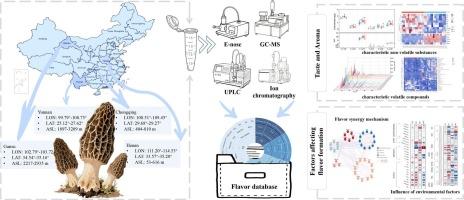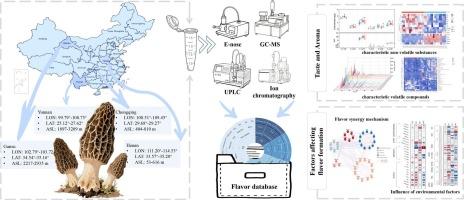Geographical flavor fingerprinting of morels: integrated analysis of volatile and non-volatile components with environmental drivers across Chinese regions
IF 9.8
1区 农林科学
Q1 CHEMISTRY, APPLIED
引用次数: 0
Abstract
Morel (Morchella spp.) is highly valued and increasingly widely cultivated in China. However, due to the limited analysis of its flavor components and origin, its full utilization is restricted. In this study, we analyzed volatile and non-volatile compounds in morels from Chongqing, Henan, Yunnan, and Gansu using an electronic nose, GC–MS, UPLC, and other techniques. The results showed that Gansu samples exhibited the strongest umami due to high Glu, while Henan samples showed malt fermentation aroma (2-methylbutanal) and sweetness (trehalose). Chongqing samples were characterized by green notes (2-octenal). Metabolic network analysis revealed correlations between aldehydes (e.g., octanal, 2-nonenal) and free amino acids (Val, Orn), with altitude identified as a key environmental factor promoting aldehyde/ketone synthesis, while soil type and geographic coordinates showed secondary associations. These findings advance the understanding of flavor formation mechanisms in morels, providing the theoretical basis for geographical traceability of processed products and flavor improvement strategies.


羊肚菌的地理风味指纹图谱:中国各地区挥发性和非挥发性成分与环境驱动因素的综合分析
羊肚菌(羊肚菌属)在中国被高度重视并日益广泛种植。然而,由于对其风味成分和产地的分析有限,制约了其充分利用。本研究采用电子鼻、气相色谱-质谱、超高效液相色谱等技术对重庆、河南、云南和甘肃产羊粪中的挥发性和非挥发性成分进行了分析。结果表明,甘肃样品由于谷氨酸含量高,鲜味最强,河南样品则表现出麦芽发酵香气(2-甲基丁醛)和甜味(海藻糖)。重庆样品以绿色音符(2-辛烯醛)表征。代谢网络分析揭示了醛类(辛醛、2-壬烯醛)与游离氨基酸(Val、Orn)之间的相关性,海拔是促进醛酮合成的关键环境因子,土壤类型和地理坐标是次要关联因素。这些发现促进了对羊肚菌风味形成机制的理解,为加工产品的地理可追溯性和风味改善策略提供了理论依据。
本文章由计算机程序翻译,如有差异,请以英文原文为准。
求助全文
约1分钟内获得全文
求助全文
来源期刊

Food Chemistry
工程技术-食品科技
CiteScore
16.30
自引率
10.20%
发文量
3130
审稿时长
122 days
期刊介绍:
Food Chemistry publishes original research papers dealing with the advancement of the chemistry and biochemistry of foods or the analytical methods/ approach used. All papers should focus on the novelty of the research carried out.
 求助内容:
求助内容: 应助结果提醒方式:
应助结果提醒方式:


